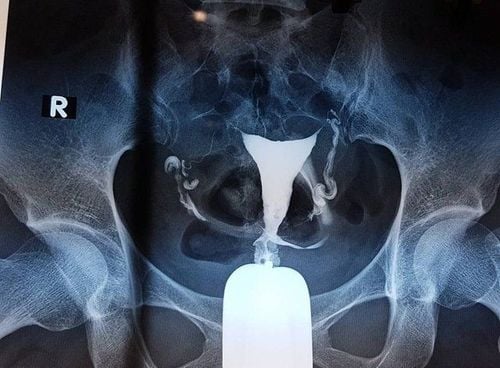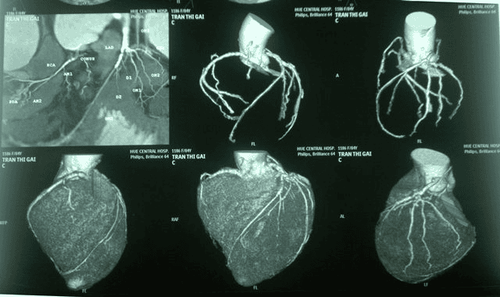This is an automatically translated article.
The article was professionally consulted with Master, Doctor Le Anh Viet - Radiologist - Department of Diagnostic Imaging and Nuclear Medicine - Vinmec Times City International Hospital.An X-ray of the uterus and fallopian tubes is an imaging test used to examine the circulation of the fallopian tubes. This test is indicated in many cases to evaluate the cause of infertility. So what do the results of the fallopian tube x-ray say?
1. What is a fallopian tube X-ray?
Hysterosalpingography - HSG is an imaging test conducted to view the inside of the uterus and fallopian tubes. This procedure requires the injection of contrast material into the uterine cavity through the vagina and cervix. Then, taking X-rays to obtain images, the doctor can observe and detect conditions such as whether the fallopian tubes are partially or completely blocked, the shape and size of the inside. Whether the uterus is normal or not, adhesions to the uterus, dilation of the fallopian tubes... or pathologies of fibroids, mucosa, uterine polyps. Thereby giving an accurate diagnosis and bringing special effectiveness in the treatment of infertility.
However, this technique is only indicated for limited use and when absolutely necessary because it is an invasive procedure that can cause unwanted harm to the uterus and fallopian tubes.
It should be noted that the HSG survey only helps to see the inside of the uterus and fallopian tubes. To evaluate for abnormalities in the ovaries, uterine wall, and other pelvic structures, ultrasound examination or MRI is required.
2. What do the ovarian X-ray results say?
X-ray of the fallopian tubes helps diagnose a number of diseases such as:Detect problems related to genital malformations such as: abnormalities in the shape and size of the uterus: double uterus, uterus with septum , bicornuate uterus, endometriosis,... Intrauterine diagnosis such as ovarian adhesions, uterine fibroids, uterine polyps,... Checking for tubal obstruction in women Infertile women evaluate for complete or partial occlusion, tubal dilatation, narrowing of the uterine waist,... Check and evaluate whether the fallopian tubes have been completely ligated or not in female sterilization.

3. Indications and contraindications to X-ray of the uterus and fallopian tubes
Indications:Find the cause of female infertility. Examine, evaluate, and suspect primary and secondary infertility caused by tubal obstruction. Test and evaluate the intrauterine contraceptive device. Abnormalities inside and outside the uterus, such as a tumor. Contraindications:
Pregnant due to the influence of X-ray Pelvic infection. This procedure should not be performed if the patient is in an inflammatory state. Your doctor may prescribe medication to completely treat pelvic inflammatory disease before the procedure. Heavy uterine bleeding at the time of the procedure. People with a history of allergy, anaphylaxis to contrast agents.

4. Some notes when taking X-ray of the uterus and fallopian tubes
Before the scan, it is necessary to do some procedures such as: gynecological examination, chlamydia test, fresh vaginal examination, blood test, abdominal ultrasound The best time to take an HSG is 3-7 days after menstruation. Before taking HSG from 5 to 8 days, do not take gastrointestinal tract with contrast agent. About 2 days before the scan, clean the vagina with an antiseptic and use prophylactic antibiotics if prescribed by the doctor. Abstain from sex for a few days before the hysteroscopy. After completing the hysterosalpingogram, the patient will be asked to stay in the hospital for 30-45 minutes for observation. In case of abnormal symptoms, the patient must immediately report to the doctor for timely treatment measures. In addition, patients may experience symptoms after performing a fallopian tube X-ray such as:Less vaginal bleeding. Spasms Feeling dizzy, faint, or upset in the abdomen. Vaginal discharge with a foul odor Vomiting fainting Severe abdominal pain or cramps Fever or chills.

Basic gynecological examination and screening package for female customers, has no age limit and may have the following symptoms:
Abnormal vaginal bleeding Having menstrual problems: irregular menstrual cycle, irregular menstrual cycle Irregular vaginal discharge (smell, different color) Vaginal pain and itching Female clients have several risk factors such as poor personal hygiene, Unsafe sex, abortion,... Female customers have other symptoms such as: Abnormal vaginal discharge, itching, pain in the intimate area, abnormal vaginal bleeding.
Please dial HOTLINE for more information or register for an appointment HERE. Download MyVinmec app to make appointments faster and to manage your bookings easily.














